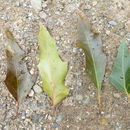en
names in breadcrumbs


The genus Quercus is one of the most significant cladistic groups of woody angiosperms in the Northern Hemisphere, based upon diversity as well as ecological dominance. Species of oaks are prominent members of many plant communities including: oak woodlands, temperate deciduous forests, matorral, pine-oak forests, chaparral-oak associations, tropical and subtropical savannas, tropical montane and premontane forests.
Fagaceae are woody trees and shrubs whose nut is enclosed in a shell-like casing. The Fagaceae family originated in Asia, first appearing in the fossil record during the Early Cretaceous, more than 100 million years ago. Subsequent radiation toward Europe and North America produced geographic dispersion as well as divergence of genera. The chromosomal composition across the entire family is remarkably similar (2n=24), but there are isolated triploid Quercus species. The extinct genus Dryophyllum, one of the earliest known Fagaceae, is believed to be the ancestor of modern oaks.
Based on molecular genetics analysis, the genus Quercus is estimated to have separated from Castanea about 60 million years ago. Oaks first appear in the fossil record in North America during the Paleogene between 55 to 50 million years b.p. Most interspecific separations occurred within the Quercus species between 22 and three million years ago. During this period, oaks became the most dominant tree type in the Fagaceae family.
Depending on the classification scheme, there are somewhere between 450 and 600 oak species; one of the chief points of confusion is the taxonomic status of many hybrid oaks. The geographical center of oak diversity is clearly in the Northern Hemisphere, particularly North America. At least 220 species occur on this continent, chiefly in Mexico and the USA. Mexico alone has 160 different oak species, 90 of which are endemic. Only one oak species occurs in South America, Quercus humboldtii, which is found in Columbia. After the Isthmus of Panama connected North and South America several million years ago, oaks propagated to the Andes, dating as early as 186,000 years before present., based upon pollen core records.
Quercus canbyi (Canby oak, Sierra oak), synonyms including Quercus graciliformis, is a North American species of oak tree.[2]
Quercus canbyi is a semi-evergreen - evergreen tree,[3] up to 40–50 feet (12–15 metres) tall in cultivation. Although, it can reach up to 80 feet (24 metres) in the wild in Mexico. It starts as a pyramidal form and then matures into an open irregular shape.[4] It can reach a spread of 30–40 feet (9.1–12.2 metres) wide.[5]
The dark, glossy green leaves are 6–8 inches (15–20 centimetres) long and have serrated edges. The petioles can have a reddish hue.[6] It blooms in March and the acorns are then seen in August.[7][8]
It has been distinguished from Quercus graciliformis by its twig shape and by producing acorns biennially rather than annually;[9] however as of February 2023, Plants of the World Online regards them as synonymous.[2]
Quercus canbyi was first described by William Trelease in 1924.[2] It is placed in Quercus section Lobatae.[10]
The species has been found only in Texas and in northeast Mexico.[2][11]
Quercus canbyi was assessed in 2016 for the IUCN Red List as "least concern".[1] Quercus graciliformis, regarded as a synonym by Plants of the World Online, was assessed as "critically endangered" in 2016.[12]
Quercus canbyi will tolerate most kinds of soils and is used in gardens to provide shade.[13]
![]() Media related to Quercus canbyi at Wikimedia Commons
Media related to Quercus canbyi at Wikimedia Commons
Quercus canbyi (Canby oak, Sierra oak), synonyms including Quercus graciliformis, is a North American species of oak tree.